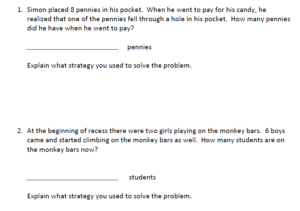MAFS.1.OA.3.6 Add and subtract within 20, demonstrating fluency for addition and subtraction within 10. Use strategies such as counting on; making ten (e.g., 8 + 6 = 8 + 2 + 4 = 10 + 4 = 14); decomposing a number leading to a ten (e.g., 13 – 4 = 13 – 3 – 1 = 10 – 1 = 9); using the relationship between addition and subtraction (e.g., knowing that 8 + 4 = 12, one knows 12 – 8 = 4); and creating equivalent but easier or known sums (e.g., adding 6 + 7 by creating the known equivalent 6 + 6 + 1 = 12 + 1 = 13).
Cognitive Complexity Level: 1-Recall
[divider] [/divider] Students are able to…
- Use a variety of materials to build and demonstrate understanding of addition and subtraction within 10.
- Demonstrate fluency with sums to 10.
- When appropriate extend to facts within 20.
[divider] [/divider] Students are able to…because teachers:
- Provide a variety of experiences to explore the benchmark of 10.
- Expect students to explain their thinking and look for patterns. For example, what happens when you add or subtract 0 or 1 from a number?
- Connect concrete models and pictorial representations to written facts.
[divider] [/divider] Questions to ask students:
- Ask: How can you figure out 4 + 5? What strategy did you use?
- Sample answer that indicates understanding: I can break apart the 5 into 4 + 1. I know that 4 + 4 = 8 and 1 more is 9.
- Ask: How can you make a model of the fact that you solved?
- Sample answer that indicates understanding: Student correctly models a problem using a concrete model or a pictorial representation.
[divider] [/divider] Additional Resources:
Additional in depth content knowledge
Blog Posts:
http://smathsmarts.com/make-a-ten-card-game/
http://smathsmarts.com/assessing-mathematical-fluency/
http://smathsmarts.com/?s=think+addition
Video: Using Known Facts to Solve New Addition and Subtraction Problems
https://learnzillion.com/lesson_plans/2125
[divider] [/divider] Sample Formative Assessment Tasks:
[divider] [/divider] Resources/Tasks to Support Your Child at Home:
Play “Make a Ten” with a deck of cards. First remove all face cards from the deck. Leave the Aces; they will count as 1. Deal out nine cards arranged in three rows and three columns. Students make a ten but picking up two cards, when put together, equal 10 (Ace & 9, 2 & 8, 3 & 7 etc). Once no more ten matches can be made, fill in the empty spaces with more cards. This game can be played individually or as a race between children. For additional support, children can count the number of symbols in the center of each card to make a ten.
The Number Bonds game is an interactive way for students to practice making ten.
